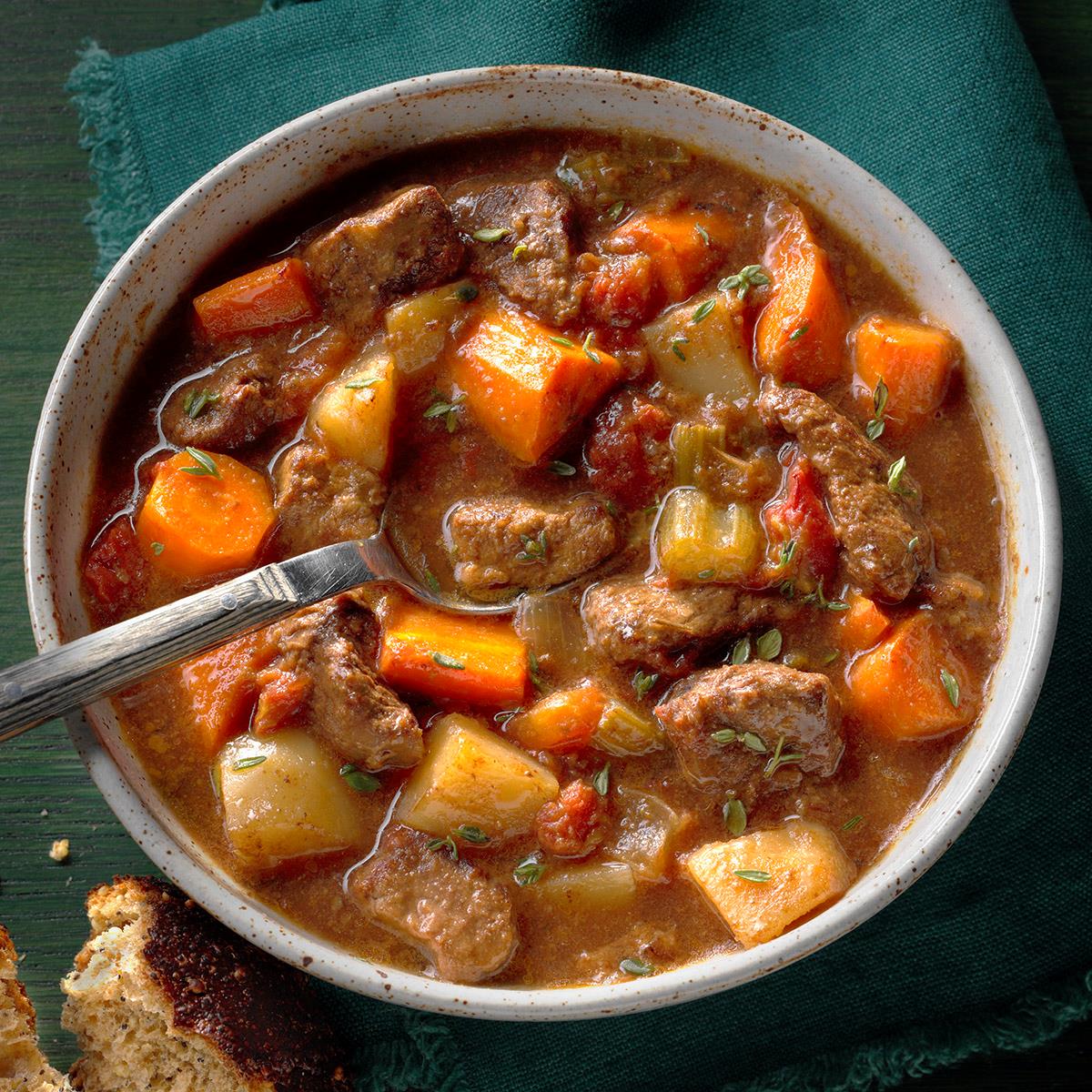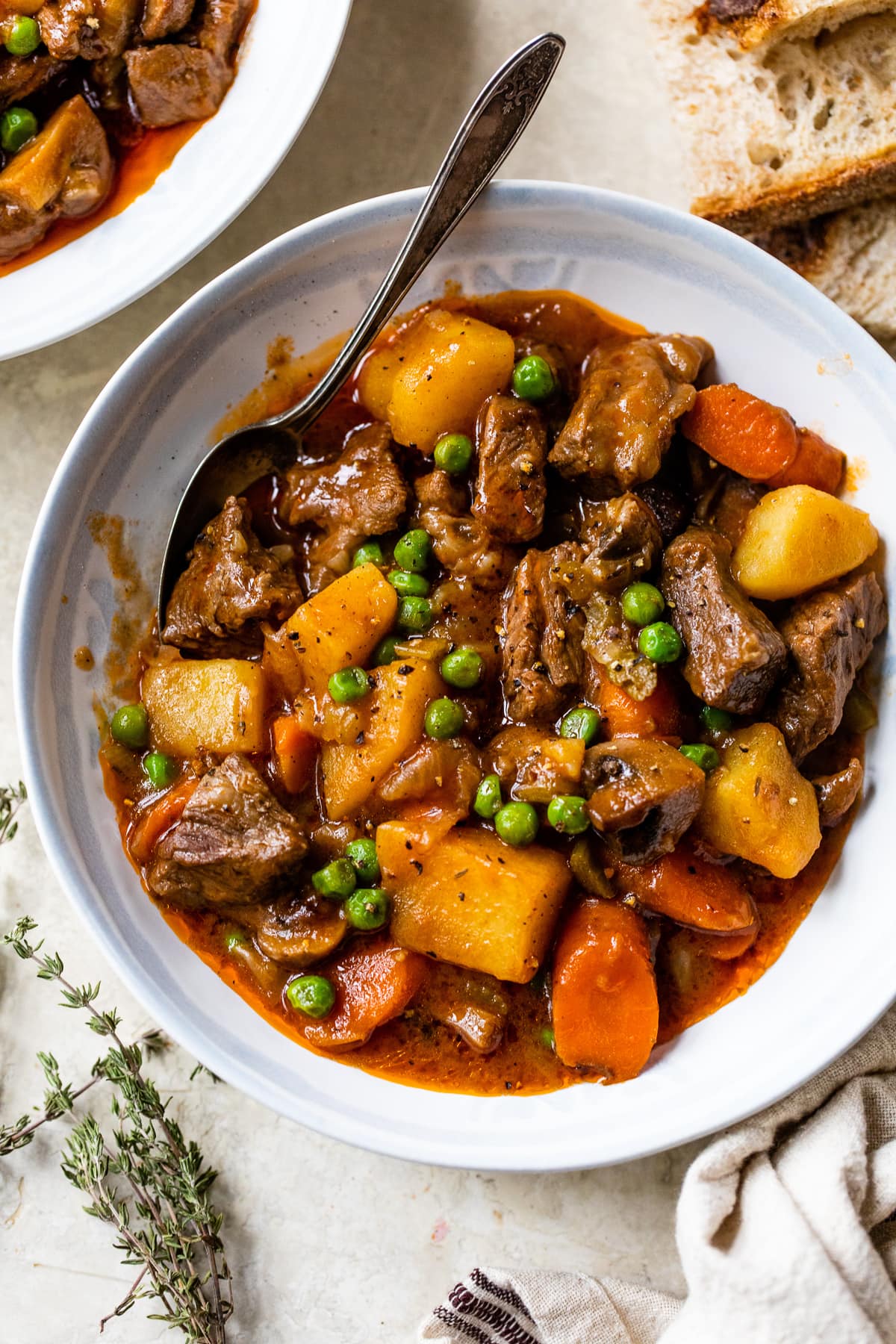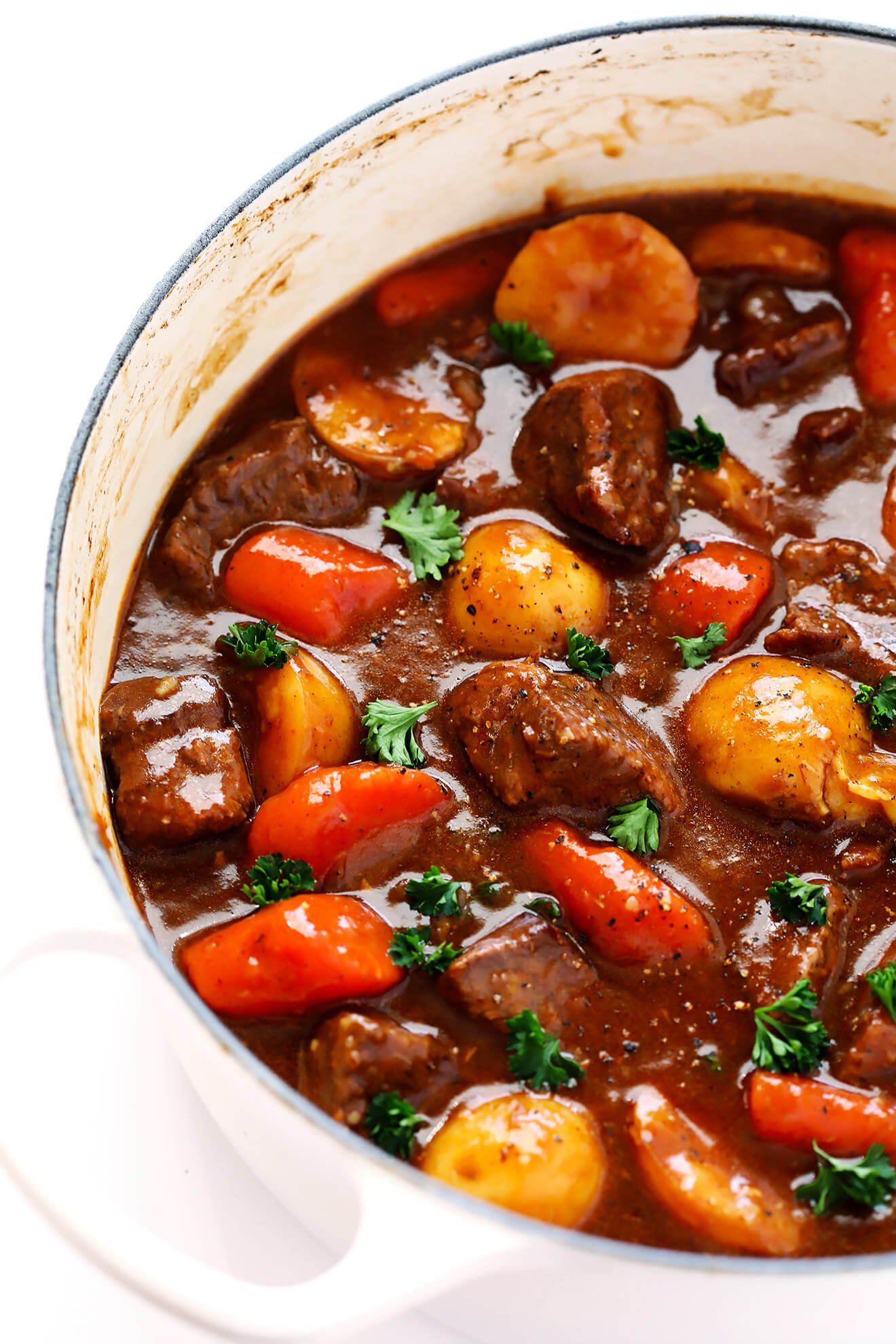Hey there, fellow food lover! Have you ever had one of those days where the chill in the air just seeps right into your bones? Or maybe you’re simply craving a dish that feels like a warm hug from the inside out? Well, you’re in the right place! Today, we’re diving deep into the magical world of beef stew recipe – a timeless classic that has graced dinner tables for generations.
Related: Melt-In-Your-Mouth Slow Cooker Country Style Ribs!
There’s something uniquely comforting about a slow-cooked beef stew. It’s more than just a meal; it’s an experience. The aroma alone, wafting through your kitchen as the rich flavors meld and deepen, is enough to make your mouth water and your spirit lift. This isn’t just any beef stew recipe; it’s the beef stew recipe you’ll want to make again and again. It’s hearty, incredibly flavorful, and surprisingly straightforward to master, even if you’re new to the kitchen.
Historically, beef stew has been a staple in many cultures, often born out of necessity – using tougher cuts of meat and whatever root vegetables were available, then slow-cooking them until tender and delicious. It’s a testament to simple, honest ingredients transforming into something extraordinary. My own memories of beef stew go back to my grandmother’s kitchen, where a simmering pot on the stove meant warmth, laughter, and a full belly. And that’s exactly what I want to share with you today.
Ready to create your own delicious memories? Let’s get cooking this amazing beef stew recipe!

Classic Hearty Beef Stew Recipe
Prep time: 30 minutes
Cook time: 2.5 – 3 hours
Servings: 6-8
Ingredients You’ll Need:
This isn’t just a list; it’s your grocery checklist for comfort! We’re using fresh, wholesome ingredients to build layers of flavor that will make this the best beef stew recipe you’ve ever tasted.
-
For the Beef:
- 2.5 lbs boneless beef chuck, cut into 1.5-2 inch cubes
- 1 teaspoon salt
- ½ teaspoon black pepper
- ¼ cup all-purpose flour (for dredging)
- 2 tablespoons olive oil (or vegetable oil)
![beef stew recipe beef stew recipe]()
-
Aromatics & Vegetables:
- 2 tablespoons unsalted butter
- 2 large yellow onions, chopped (about 3 cups)
- 4 cloves garlic, minced
- 1 lb carrots, peeled and cut into 1-inch pieces (about 4-5 medium carrots)
- 1.5 lbs small red potatoes, quartered (or larger potatoes cut into 1.5-inch chunks)
- 1 cup frozen peas (added at the end)
![beef stew recipe beef stew recipe]()
-
Liquids & Flavor Boosters:
- 2 cups beef broth (low sodium preferred)
- 1 cup dry red wine (like Merlot or Cabernet Sauvignon) – optional, but highly recommended for depth
- 1 (14.5 ounce) can diced tomatoes, undrained
- 2 tablespoons tomato paste
- 1 tablespoon Worcestershire sauce
- 2 bay leaves
- 1 teaspoon dried thyme
- ½ teaspoon dried rosemary (crushed)
-
For Thickening (if needed, at the end):
- 2 tablespoons cold water
- 2 tablespoons all-purpose flour (or cornstarch for gluten-free)
-
Garnish:
- Fresh parsley, chopped (for serving)
Step-by-Step Instructions: Crafting Your Perfect Beef Stew
Follow these steps closely, and you’ll be rewarded with a rich, tender, and deeply satisfying beef stew recipe. Remember, patience is key to unlocking all those incredible flavors!
Step 1: Prep the Beef for Perfection
- Pat the beef cubes very dry with paper towels. This is crucial for achieving a good sear!
- In a large bowl, toss the beef with salt, pepper, and flour until evenly coated. The flour will help create a beautiful crust and also thicken the stew later.
Pro Tip: Don’t overcrowd the pan when searing! If you put too much beef in at once, it will steam instead of brown. Work in batches to get that gorgeous, deep brown crust on all sides. This browning step (called the Maillard reaction) adds incredible depth of flavor to your beef stew.
Step 2: Sear the Beef
- Heat 2 tablespoons of olive oil in a large Dutch oven or heavy-bottomed pot over medium-high heat until shimmering.
- Add about half of the floured beef cubes in a single layer. Sear for 3-4 minutes per side, until deeply browned.
- Remove the seared beef to a plate and repeat with the remaining beef. Set all the seared beef aside.
Step 3: Sauté the Aromatics
- Reduce the heat to medium. Add 2 tablespoons of butter to the pot.
- Add the chopped onions and cook, stirring occasionally, until softened and translucent, about 5-7 minutes. Scrape up any browned bits from the bottom of the pot as you stir – that’s pure flavor!
- Add the minced garlic and cook for another minute until fragrant. Be careful not to burn the garlic.
Pro Tip: Those browned bits at the bottom of the pot? That’s called "fond," and it’s gold! Don’t clean it out. The next step will help you scrape it up and incorporate it into your stew.
Step 4: Deglaze and Build the Base
- Pour in the red wine (if using) and bring it to a simmer, scraping the bottom of the pot with a wooden spoon to release all those flavorful browned bits. Let it simmer for 2-3 minutes until the alcohol smell dissipates slightly.
- Stir in the tomato paste, Worcestershire sauce, dried thyme, and crushed rosemary. Cook for 1 minute, stirring constantly. This toasts the spices and tomato paste, enhancing their flavor.
Step 5: Combine and Simmer
- Return the seared beef to the pot.
- Pour in the beef broth and add the undrained can of diced tomatoes and bay leaves.
- Stir everything together, making sure the beef is mostly submerged.
- Bring the mixture to a gentle simmer. Once simmering, reduce the heat to low, cover the pot tightly, and cook for 1.5 hours.
Pro Tip: Low and slow is the way to go for a tender beef stew. Don’t be tempted to rush it by cranking up the heat. This slow cooking breaks down the tough fibers in the chuck beef, making it incredibly tender and melt-in-your-mouth delicious.
Step 6: Add the Root Vegetables
- After 1.5 hours, carefully remove the lid. Add the carrots and potatoes to the pot. Stir gently to combine.
- Re-cover the pot and continue to simmer for another 45 minutes to 1 hour, or until the vegetables are fork-tender and the beef is incredibly tender.
Pro Tip: Adding the root vegetables partway through ensures they cook through but don’t turn to mush. We want them tender, but still holding their shape.
Step 7: Final Touches & Thickening (if needed)
- Remove the bay leaves from the stew.
- Stir in the frozen peas and cook for 5 minutes, or until heated through.
- Taste the stew and adjust seasoning (salt and pepper) if necessary.
- To Thicken (optional): If your stew isn’t as thick as you like, whisk together 2 tablespoons cold water and 2 tablespoons flour (or cornstarch) in a small bowl until smooth. Slowly whisk this slurry into the simmering stew. Cook, stirring constantly, for 2-3 minutes until the stew has thickened to your desired consistency.
Step 8: Serve and Enjoy!
- Ladle the hot beef stew into bowls.
- Garnish with fresh chopped parsley.
- Serve immediately with crusty bread, mashed potatoes, or rice.
Extra Tips for the Best Beef Stew Recipe Ever!
This isn’t just a recipe; it’s a guide to mastery. Here are some extra nuggets of wisdom to elevate your beef stew experience!
Cooking Tips:
- Don’t Skip the Sear: Seriously, this is non-negotiable for a truly flavorful beef stew. It creates those beautiful browned bits (fond) that are the foundation of your stew’s deep flavor.
- Low and Slow is the Goal: Patience is your best friend here. Tough cuts of beef need time to break down and become tender. Rushing it will result in chewy meat.
- Taste and Adjust: Always taste your stew before serving. A little more salt, a pinch of pepper, or even a dash more Worcestershire can make all the difference.
- Day-Old Stew is Gold: Like many braised dishes, beef stew often tastes even better the next day. The flavors have more time to meld and deepen. Make it ahead of time for easy entertaining!
Variations & Substitutions:
- Wine Alternatives: If you prefer not to use wine, simply use an additional cup of beef broth. You can also add a splash of balsamic vinegar for a touch of acidity and depth.
- Herb Power: Experiment with fresh herbs like a sprig of fresh rosemary or a few sprigs of fresh thyme tied together with kitchen twine (remove before serving).
- Spice It Up: For a subtle kick, add a pinch of red pepper flakes with the garlic.
- Different Veggies: Feel free to add other root vegetables like parsnips or turnips along with the carrots and potatoes. Mushrooms are also a fantastic addition, added about 30 minutes before the end of cooking.
- Gluten-Free Option: For a gluten-free beef stew recipe, skip the flour dredge for the beef and use cornstarch (mixed with cold water) for thickening at the end instead of flour.
Serving Ideas:
- Crusty Bread: Essential for soaking up every last drop of that glorious gravy. A warm baguette or sourdough is perfect.
- Mashed Potatoes: Serve the stew over a bed of creamy mashed potatoes for an extra comforting meal.
- Rice or Pasta: Simple white rice or even egg noodles make a great base for your hearty beef stew.
- Polenta: For a rustic touch, serve over soft polenta.
- Side Salad: A simple green salad with a vinaigrette can offer a nice fresh contrast to the richness of the stew.
Nutritional Information (Estimated Per Serving)
Please note: This is an estimated nutritional breakdown and can vary based on specific brands and exact measurements.
- Calories: 450-550 kcal
- Protein: 40-50g
- Fat: 20-25g
- Saturated Fat: 8-10g
- Carbohydrates: 30-40g
- Fiber: 5-7g
- Sodium: 600-800mg
This beef stew recipe is packed with protein, fiber, and essential vitamins and minerals from all those wonderful vegetables. It’s truly a wholesome meal!
Frequently Asked Questions (FAQ) about Beef Stew
Got questions about making the perfect beef stew recipe? I’ve got answers!
Q1: Why is my beef stew tough?
A: The most common reason for tough beef stew is not cooking it long enough or at too high a temperature. Chuck beef, while flavorful, is a tougher cut and needs low, slow cooking to break down its connective tissues and become tender. Don’t rush the simmering process!
Q2: How can I thicken my beef stew?
A: Our recipe uses a flour dredge on the beef and a flour slurry at the end. If it’s still not thick enough, you can make a simple slurry of 1-2 tablespoons of flour or cornstarch mixed with an equal amount of cold water. Whisk it into the simmering stew and cook for a few minutes until it thickens. For a richer, naturally thickened stew, reduce the liquid further by simmering uncovered for the last 15-30 minutes.
Q3: Can I make this beef stew recipe in a slow cooker or Instant Pot?
A: Absolutely!
- Slow Cooker: Follow steps 1-4 (searing beef and sautéing aromatics) on the stovetop. Transfer everything to your slow cooker. Add the beef broth, tomatoes, seasonings, and beef. Cook on low for 6-8 hours or on high for 3-4 hours. Add the carrots and potatoes during the last 2-3 hours of cooking. Add peas at the very end.
- Instant Pot: Use the sauté function for steps 1-4. Deglaze with wine/broth. Add all ingredients except peas. Pressure cook on high for 35-40 minutes (for tender beef). Let natural release for 10 minutes, then quick release. Add peas and simmer on sauté mode for 5 minutes.
Q4: How long does beef stew last in the refrigerator?
A: Properly stored in an airtight container, homemade beef stew can last for 3-4 days in the refrigerator.
Q5: Can I freeze beef stew?
A: Yes! Beef stew freezes beautifully. Let it cool completely, then transfer to freezer-safe containers or heavy-duty freezer bags. It can be stored in the freezer for up to 3 months. Thaw overnight in the refrigerator before reheating gently on the stovetop or in the microwave. The potatoes might become slightly softer upon thawing, but the flavor will still be fantastic.
Conclusion: Your Next Culinary Masterpiece
There you have it! A comprehensive guide to creating a beef stew recipe that’s not just food, but a hearty, soul-warming experience. This classic dish proves that some of the best meals are the ones that take a little time, infusing every bite with love and flavor.
Whether you’re battling a chilly evening, hosting a cozy gathering, or simply craving a taste of home, this beef stew recipe is sure to hit the spot. It’s a testament to simple ingredients coming together to create something truly magnificent.
So, roll up your sleeves, gather your ingredients, and get ready to fill your home with the most incredible aromas. I promise you, the effort is worth every single delicious bite.
I’d love to hear from you! If you try this beef stew recipe, please come back and leave a comment below. What’s your favorite part? Did you add any special touches? Share your culinary adventures with us! Happy cooking!



